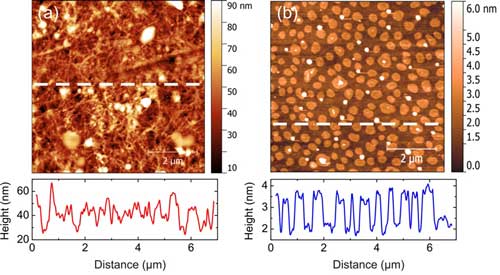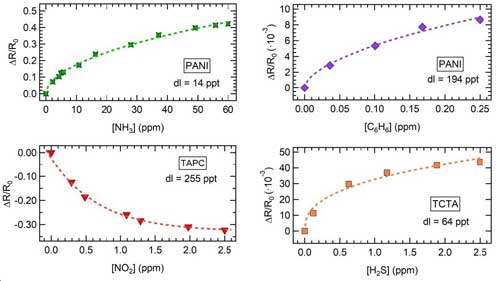Carbon nanotubes pave the way for human lung disease analysis
QQ Academic Group: 1092348845
Detailed
| Instant healthcare is still a challenging technology. Various sensors can be integrated into the wearable device to monitor different health parameters, such as temperature and pulse rate. However, to provide in-depth health analysis and predict the existence of diseases, complex diagnostic tools such as MRI, computed tomography, etc., or body fluid analysis of blood and saliva are still required. | |
| Breathing is one of the main sources of human health parameters and can be used to predict the state of different internal organs. The composition of exhalation is very complex, and the presence of disease marker molecules can be as low as 1 ppm (parts per million). This means that using respiration for health monitoring purposes requires highly sensitive tools and requires recognition capabilities as low as a single molecule. | |
| Among the various breath analysis methods, the most promising one is based on the concept of electronic nose . Here, the task of certain disease pattern recognition is to move from hardware to software using advanced data analysis methods. This concept can both miniaturize the sensor design and speed up the response time. However, the development of sensor platforms with high sensitivity for information molecules with high humidity background in exhaled breath is still challenging. | |
| A team of researchers from Catatolica del Sacro Cuore University in Italy, Skolkovo Institute of Science and Technology (Russia) and National University of Electronic Technology (Russia) has developed a rapid, on-site and still accurate breath analysis method that does not require special breath sample preparation . The method is based on an electronic nose platform that uses a set of single-walled carbon nanotube (SWCNT) sensors deposited on a flexible substrate and modified with different semiconductor organic molecules. | |
| Carbon nanotubes are widely used in the development of electronic noses due to their high sensitivity to environmental gases, high stability, and inherent changes in electronic characteristics, making them very suitable for use in electronic nose platforms. The researchers recommend that additional functionalization be used to improve the recognition characteristics of the SWCNT sensor. This feature can improve the specificity of the sensor for different gases, making sub-ppm analysis possible. | |
| Scientists published their findings in advanced medical materials ( "Development of Sensory Array for Human Breath Analysis Based on SWCNT Layer Functionalized by Semiconductor Organic Molecules" ). | |

|
|
| The image shows that the SWCNT film on PET is covered by a single layer of organic molecular crystals (left). For comparison, the right panel shows AFM images of molecules deposited on the satellite glass substrate in the same process. The corresponding cross section (white line) is shown below the image. (Photo: National University of Electronic Science and Technology) (click on the image to enlarge) | |
| The researchers demonstrated the performance of the method by analyzing various gases and vapors (ammonia, ethanol, acetone, 2-propanol, sodium hypochlorite, benzene, hydrogen sulfide, and nitrogen dioxide). For each nanotube sensor area of approximately 1 cm 2 , the sensitivity proved to be as low as 0.25 ppm, and there was a higher degree of discrimination between gases. The optimal detection limit of ammonia is shown as nanotubes covered by PANI molecules, and CNTs covered by TCTA molecules of hydrogen sulfide are 0.014 and 0.064 ppm. | |
| In addition, the research team also proved that these sensors can be used to identify chronic obstructive pulmonary disease (COPD) based on the breath analysis results of 21 patients. Advanced data analysis methods based on principal component analysis provide a clear distinction between subjects with and without COPD. | |

|
|
| Calibration curve of resistance change of the best performance sensor under NH 3 , NO 2 , H 2 S and C 6 H 6 exposure and target gas concentration and detection limit (dl) . (Photo: National University of Electronic Science and Technology) (click on the image to enlarge) | |
| The research team led by Professor L. Sangaletti has proven their high-performance induction platform in respiratory recognition, with a relatively fast response time, without the need for complex respiratory therapy. In the case of COPD, they observed that analysis can be improved by appropriately targeting specific molecules of cause of death. | |
| The main advantage of this electronic nose platform is that it is possible to achieve miniaturization and integration on chips compatible with conventional microelectronics technologies in the future, thus paving the way for on-site analysis using smartphones. | |
| The project is partly funded by the ANAPNOI project (Sacred Heart Catholic University) and the Russian Science Foundation. |
Source of information: Nanowerk
statement:
It is purely academic and non-commercial. If there is any infringement, please contact us immediately. We will delete it as soon as possible to protect the intellectual property of the original author. Thank you teachers and students for your attention and support.
- Previous: Inject biomedical elec
- Next: A Rising 2D Star: Nove


 Academic Frontier
Academic Frontier